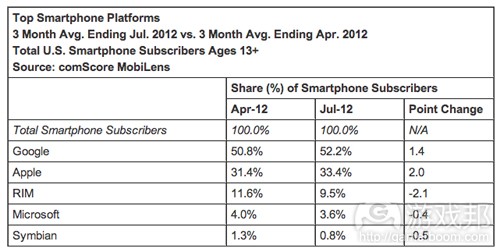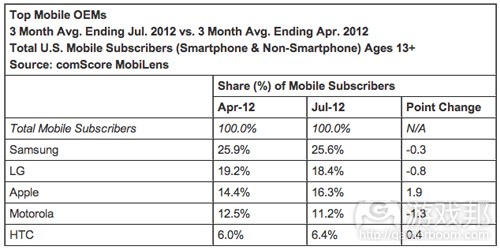每日观察:关注《愤怒的小鸟》续集游戏《Bad Piggies》(9.5)
1)据gamasutra报道,Rovio日前宣布将于9月27日推出《愤怒的小鸟》续集游戏《Bad Piggies》。
该游戏将以小猪角色为中心,将首先入驻iOS、Android和Mac平台,随后还将推出Windows Phone、Window 8和PC版本。
2)comScore最近报告指出,在2012年4月至6月,苹果智能手机市场份额增长2个百分点,占比达33.4%,而Android则增长1.4个百分点,占比达52.2%。
这一结果与comScore今年4月份报告相似,当时苹果市场份额增速也最为明显,占比达31.4%,而Android则占比50.8%。与此同时,RIM和微软市场份额则分别降至9.5%和3.6%。
尽管Android市场份额有增无减,但多数领先的Android设备制造商所占份额却有所下滑。三星下跌0.3个百分点,LG下降0.8个百分点,摩托罗拉则下降1.3个百分点,只有HTC增长了0.4个百分点。但三星目前仍是美国排名第一的智能手机设备制造商,占比达25.6%(游戏邦注:据Canaccord Gennuity数据显示,三星Galaxy S III是8月份美国第一热销智能手机)。
comScore数据还指出,自4月份以来使用手机发短信、下载应用、登录社交网络及上网的用户比例也呈现增长趋势。玩手机游戏的用户比例已从4月份的33.1%增长至7月份的33.8%;下载应用的用户比例则从原来的50.2%增长至52.6%。
3)据pocketgamer报道,苹果日前正式邀请媒体于9月12日参与新iPhone产品发布会。
与过去一样,这次邀请邮件的内容仍然不甚至详细和明确,但观察者认为从邮件中的“12”这个数字的倒影是“5”这个设计来看,新设备名称很可能就是“iPhone 5”而非“iPhone 4X”、“iPhone 6”或“新iPhone”。
有传闻称iPhone 5将采用更长的4英寸屏幕,更轻薄的底盘,更小的连接器,美国用户还可能享受4G服务。
4)据Engadget报道,Mozilla将于2013年推出Firefox OS Marketplace应用商店,从其泄露的图片设计来看,该应用商店所走路线可能与亚马逊Appstore等竞争对手并不相同。
该应用商店侧重于显示单种类型的应用,而非显示成排成列的推荐应用。从这个早期图片来看,目前该应用商店并未呈现重大创新性。
5)法国发行商Gameloft日前提高了2012年的销售预期,从原先预计的2亿欧元(2.51亿美元)提升至2.05亿欧元(2.57亿美元)。
该公司预计其总收益将比上年增长25%,计划在2012下半年推出20款新智能手机和平板电脑游戏(上半年推出了11款游戏)。
Gameloft在上半年净利润为460万欧元(570万美元),同比上年的530万欧元(660万美元)下降了13%,该公司称这一结果可能与研发成本增长有关。该时期其毛利润为86%,同比上年下滑2%,这可能与Gameloft需向第三方支付版权费有关(例如《Ice Age Village》等授权游戏)。
上半年Gameloft北美收益占比32%,欧洲和中东收益占比26%,亚太占比22%,拉美占比21%,目前该公司共有5700万月活跃用户(7月份时为5500万)。
6)据techcrunch报道,美国/德国运营商计费服务公司mopay最近数据显示,从2008年至2011年末,移动计费服务的流量增长了4倍左右(游戏邦注:mopay分析了80个国家/地区的300名客户的400万笔交易数据)。
手机游戏是目前运营商计费服务的主要收益来源,在所有交易中占据半数比例,并且年均增幅将近30%。传统手机游戏目前每用户平均收益为4.5美元/每月,增幅仅为10%;而手机社交游戏每用户平均收益超过5美元/每月,增幅超过40%。
从更广泛的层面来看,社交媒体应用在所有运营商计费交易中占比5%。(本文为游戏邦/gamerboom.com编译,拒绝任何不保留版权的转载,如需转载请联系:游戏邦)
1)Rovio follows up Angry Birds with Bad Piggies
By Mike Rose
Angry Birds developer Rovio isn’t done with the behemoth franchise just yet. Today the company announced a sequel to the original game that looks to focus on the story from the prespective of the pigs.
Bad Piggies is set to launch on September 27 for iOS, Android and Mac, with editions for Windows Phone, Windows 8 and PC to follow shortly afterwards. The game will give players the chance to take control of the enemies from the original series.
Rovio has seen great success with its Angry Birds franchise, racking up more than one billion downloads across all versions, and hence is no doubt keen to capitalize on that popularity with this follow-up. (source:gamasutra)
2)Apple smartphone market share continues to rise
Scott Reyburn
Apple is growing its share of the smartphone market faster than Google is, according to comScore’s latest Mobile Subscriber Market Share report. ComScore found between April and July 2012, Apple’s market share increased by two percent, rising to 33.4 percent overall, while Android grew by 1.4 percent, good for 52.2 percent of the smartphone market.
The results are similar to comScore’s April Mobile Subscriber Market Share report, which also showed Apple’s share of the smartphone market was the fastest growing. At the time Apple controlled 31.4 percent of the market, with Android accounting for 50.8 percent.
Although Google’s Android operating system did see its market share increase, most of the leading Android OEMs saw their individual market share decline. Samsung dropped -0.3 percent, LG fell -0.8 percent and Motorola had the most significant hit at -1.3 percent. HTC, meanwhile was the lone Android manufacturer to see an increase in market share, with a gain of 0.4 percent. Although Samsung fell, it remains the top smartphone manufacturer overall in the U.S., accounting for 25.6 percent of the market. The company’s recently released Galaxy S III was also the top selling U.S. smartphone in August, according to Canaccord Genuity.
Both Apple and Google’s gains seemed to come at the expense of RIM and Microsoft, which saw their market shares decline to 9.5 percent and 3.6 percent, respectively.(source:insidemobileapps)
3)Confirmed: Apple will reveal the iPhone 5 on September 12th
by Mark Brown
Apple has sent out its annual invitation to a media briefing for the next iPhone. Come September 12th, Tim Cook will take the stage in Cupertino and reveal the new gadget.
The invitation is, as usual, sparse and devoid of any useful information. However, the shadow on the big ’12′ is the number ’5′, which means the device will probably be called ‘iPhone 5′, and not’iPhone 4X’ or ‘iPhone 6′ or ‘the new iPhone’.
If our rumour round-up is anything to go by, the iPhone 5 will feature a taller 4-inch screen, a thinner chassis, a smaller dock connector, and a nano-SIM tray. Phone owners in the US might also see 4G compatibility.
Join us at 5pm GMT on September 12th for our live blog on Apple’s latest gizmo. We’ll also be posting loads of spin-off articles on the next-gen iPhone for those seeking more detail.(source:pocketgamer)
4)Firefox OS Marketplace image leak
by Mike Shaw
Mozilla is getting its mobile OS marketplace ready for launch in 2013.
In images leaked to Engadget, it seems that the mobile Firefox OS Marketplace is going in a different direction to rivals like the Amazon Appstore.
The screenshots show a minimalist store focused on individual categories rather than pushing row after row of highlighted apps.
There’s doesn’t appear to be anything particularly revolutionary about the marketplace so far, and there are only free apps on offer in these early images, but its a sign that Mozilla is getting close to completing its OS for a launch in 2013.(source:mobile-ent)
5)Gameloft increases full year sales guidance to €205M
Kathleen De Vere
French mobile developer Gameloft has increased its full year sales guidance for 2012 to €205 million ($257 million), up from the €200 million ($251 million) in annual sales the company predicted it would see after releasing its second quarter financial results in July.
According to the new figures released today, Gameloft is expecting its total revenues to increase by 25 percent year-over-year, largely due to growth from its smartphone and tablet titles. The company is planning to launch 20 new smartphone and tablet titles in the second half of the year, up from the 11 titles it launched during the first half.
Overall during the first half of 2012, Gameloft earned €4.6 million ($5.7 million) in net profit, down 13 percent year-over-year from the €5.3 million ($6.6 million) it earned during the same period in 2011. Gameloft pinned the decline on increased R&D costs. The company’s gross margin also dropped slightly, falling 2 percent year-over-year to 86 percent, mainly due to the increased success of licensed games like Ice Age Village, which require Gameloft to pay royalty fees to third parties.
The company’s sales for the first half of the year were evenly distributed worldwide, with North America accounting for 32 percent, Europe and the Middle East 26 percent, Asia Pacific 22 percent and Latin America 21 percent. Gameloft now boasts 57 million monthly active users, up from the 55 million MAU it reported in July.(source:insidemobileapps)
6)Social Gaming, Dating Account For The Biggest Growth In Carrier Billing
Ingrid Lunden
Over the last year, we have seen some notable advances in mobile carrier billing — which lets people pay for services and content on their phones by charging it to their carrier bills: Google expanded its carrier billing services to music and more; Facebook joined the ranks of those offering it, and Amazon has a deal with a company that could help it potentially roll out such services, too. (Noticeably absent is Apple; more on that below.) Now, data shared with TechCrunch by U.S./German carrier billing company mopay provides a look at just how much money these kinds of services are making.
Analysing data from some 4 million transactions across some 300 customers in 80 countries, between 2008 and the end of 2011, mopay says that traffic on mobile billing services has increased four-fold. And along with the traffic increase has been one in value.
Mobile gaming, which has been an early and popular application for carrier billing, is currently the biggest generator of carrier billing revenues, accounting for over half of all transactions and growing at a rate of almost 30% year-to-year. Within that, some areas are doing better than others: traditional mobile games currently bringing in $4.50 per month, and have grown by only 10%; but, perhaps because it is a newer market, social gaming is seeing a much stronger rise: its average revenues per user are up by 40% to over $5 per month.
And on a wider scale, social media applications accounted for 5% of all carrier billing transactions.
Mobile security, mobile ticketing and offers of services specific to your mobile device (eg ringtones) all average at between $2 and $5.
Online Dating has grown by 25% and is currently bringing in $6.50 per month in revenues among individuals using these services.
What’s bringing in premium spending? Premium content — and charity. Mopay says that entertainment offers and “special interest” social networking services are seeing spend of up to $10 per month, an amount only rivaled by charity spend.
Mopay notes that in those situations where carrier billing is enabled, it is leading to more people using it: in over 30 countries where the service is turned on, mopay says that people are on average spending within 80% of their carrier credit lines.
And there seems to be signs that those using carrier billing continue to use it. More than half of users in a period of six months will use carrier billing more than once. Some 55% of users used carrier billing more than five times in that period.
But some countries seem more taken by carrier billing than others: Italy has a lot of single users who return only 25% of the time. Brazil’s carrier billing users, meanwhile, return 70% of the time, with two-thirds of that group making more than five carrier-billing based purchases.
This is partly due, mopay says, to Brazil having a lower penetration of credit cards but a very high mobile penetration; together that drives more interest in using a service like this to make transactions.
Ironically, for all its purported convenience, carrier billing is still a relatively little-used and little-known way for people to pay for content. “As more organizations adopt direct to carrier billing and consumers realize this option exists, we anticipate these numbers will continue to rise in the future,” notes Kolja Reiss, managing director at mopay. Those italics are mine.
Would having a company like Apple get involved in offering carrier billing change the game by raising awareness?
It’s anyone’s guess whether Apple will follow its competitors and offer carrier billing in the App Store — it’s been something rumored here and there, especially around its emerging market strategy. (That would fit nicely with mopay’s own conclusions that these markets are proving much stronger for carrier billing services than some developed markets. It would also run counter to how Apple has developed its content services up to now, with the App Store creating a direct relationship with the device owner and cutting out any operator relationship in the process.)
Apple’s next iPhone event is, if rumors are true, taking place September 12. Since Apple revealed its Passbook service during WWDC in June, most mobile payment attention has been focused on how Apple might leverage Passbook as a step in the direction of an “iWallet” integrating iTunes and using a combination of QR Codes, and possibly more, to trigger an on-phone response to a physical object near it.(source:techcrunch)















































 闽公网安备35020302001549号
闽公网安备35020302001549号